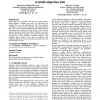Free Online Productivity Tools
i2Speak
i2Symbol
i2OCR
iTex2Img
iWeb2Print
iWeb2Shot
i2Type
iPdf2Split
iPdf2Merge
i2Bopomofo
i2Arabic
i2Style
i2Image
i2PDF
iLatex2Rtf
Sci2ools
GECCO
2007
Springer
2007
Springer
The effect of user interaction mechanisms in multi-objective IGA
In this paper four mechanisms, fine and coarse grained fitness rating, linguistic evaluation and active user intervention are compared for use in the multi-objective IGA. The interaction mechanisms are tested on the ergonomic chair design problem. The active user intervention mechanism provided the best fitness convergence but resulted in the least diverse results. The fine grained evaluation provided a good blend of fitness convergence and diversity while the popular coarse grained discrete rating provided poor results. Linguistic evaluation resulted in poor qualitative fitness despite its fast speed of evaluation. The significant differences between interaction mechanisms show the need for further research. Categories and Subject Descriptors I.2.8 [Computing Methodologies]: Artificial Intelligence – problem solving, control methods and search. General Terms Algorithms, design Keywords IGA, multi-objective optimization, user interaction, design optimization, ergonomic chair design....
| Added | 07 Jun 2010 |
| Updated | 07 Jun 2010 |
| Type | Conference |
| Year | 2007 |
| Where | GECCO |
| Authors | Alexandra Melike Brintrup, Hideyuki Takagi |
Comments (0)

